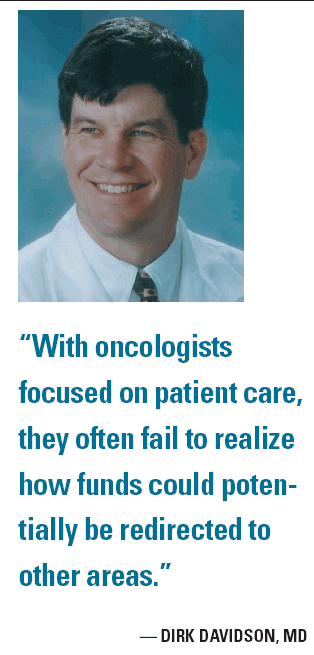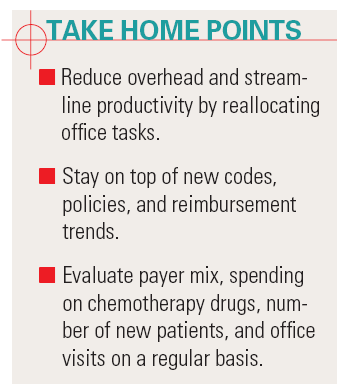Four steps to improve the profitability of your oncology practice
Running a successful oncology practice requires you to be one part doctor, one part CEO. After all, your practice demands a skilled combination of high-quality patient care and business acumen. And with countless office procedures and mountains of paperwork involved, your practice also requires that you pay close attention to even the smallest details, which means that you must also serve as an auditor and a chief financial officer. The survival of the practice, like the quality of the care you deliver, rests in the details.
ABSTRACT: An oncologist must be a physician and a CEO. The survival of the practice, and the quality of the care you deliver, rests in the details.
Running a successful oncology practice requires you to be one part doctor, one part CEO. After all, your practice demands a skilled combination of high-quality patient care and business acumen. And with countless office procedures and mountains of paperwork involved, your practice also requires that you pay close attention to even the smallest details, which means that you must also serve as an auditor and a chief financial officer. The survival of the practice, like the quality of the care you deliver, rests in the details.

These details include the specific set of billing codes that oncology practices are required to use. When compared with other specialties, any errors and inefficiencies in oncology billing are greatly magnified, making it imperative to have a nearly flawless billing and management process. And since oncology practices must purchase millions of dollars of chemotherapeutic agents, small price differences can add up.
Having the proper technology tools and expertise can streamline office processes, enabling oncologists to focus on providing optimal care. By taking a few simple steps, oncology practices can significantly boost profits and increase office efficiencies, while keeping patient care at the forefront.
Practice effective drug management
Administering chemotherapy is the foundation of an oncology practice’s income. This dependence increases pressure on the practice, while the nature of the treatment presents a unique insurance reimbursement problem. Maintaining an accurate drug inventory and precisely recording the administration of all chemotherapy drugs are critical factors in maximizing profit and avoiding losses.
In fact, just one inaccurate billing can equal one day’s income. Would your practice purposely not collect payment on a patient visit? In essence, that is what you are doing if your inventory and administrative details are not in order.
Two of the best ways for oncology practices to stay solvent are to pay less for chemotherapy drugs and to record drug inventory accurately. Since the majority of oncology practices’ expenses stem from chemotherapy drugs, establishing relationships with drug manufacturers and wholesalers is an important factor in a practice’s financial success. Practices should find wholesalers offering reasonable drug prices and negotiate to obtain the best prices.
Evaluating manufacturer buy-ins and contracts with drug companies is also necessary to maximize profit margins. In addition, having a cash reserve fund is highly recommended to allow practices to buy large quantities of drugs at low prices.
Improve office efficiency
As with high drug costs, fixed overhead-salaries, benefits, utilities, supplies, and more-can burden any oncology practice, particularly smaller ones. For many, it is not uncommon to have an overstaffed practice and higher fixed overhead than necessary. Part of the problem is that many practices are still operating at the employee- and fixed-overhead levels required prior to the Medicare Modernization Act. With oncologists focused on patient care, they often fail to realize how funds could potentially be redirected to other areas.
Practices can actively reduce overhead and streamline productivity by reallocating office tasks. For example, it may not be necessary to have three employees assigned to billing. Perhaps these workers can concentrate on other tasks that require more attention, or existing positions can be combined with others. Streamlining intra-office communications helps identify these potential areas where both efficiencies and results can be improved.
Decode the coding landscape
Billing inefficiencies can have a detrimental impact on the profit of an oncology practice. Given the expense and complexity of buying and administering chemotherapy drugs, recurring errors add up over time. Failing to record items correctly results in hundreds, if not thousands, of dollars lost.
For an oncology practice, inaccurate coding that causes a 10% drop in collections can result in a 70% profit loss.
Understanding and accurately using billing codes can mean the difference between financial life and death.
Oncology practices that take advantage of the relationship between various chemotherapy and nonchemotherapy infusion codes can see profit increase by as much as 10% to 30%. Medicare and insurance companies have reduced the reimbursement for chemotherapy drugs; therefore, it is imperative to keep informed of new codes, policies, and reimbursement trends.
Monitor your practice’s health
Just as a patient’s health requires monitoring, your practice requires financial monitoring. However, many fail to do so unless the financial situation becomes dire. Regular evaluations of payer mix, spending on chemotherapy drugs, the number of new patients, and office visits will pinpoint areas that need attention.
For example, practices must take new Medicare guidelines into consideration to plan ahead and determine the best way to deliver quality care to a large number of patients at decreased reimbursement levels. In communities where most residents are on Medicare, it is difficult to adjust the payer mix. The surging Baby Boomer population, and the decline in commercial reimbursements, means that oncologists must more frequently deliver care at Medicare reimbursement rates.

In addition, the current administration plans to offer an insurance option to younger patients that will directly compete with commercial plans. This, in turn, will likely force commercial payers to reduce their premiums and, subsequently, their hospital and physician reimbursement. Practices that are having difficulty meeting their margins must prepare for a situation that will likely become increasingly complex.
Drug spending is another area that needs consistent evaluation. With chemotherapy drugs and sessions being the biggest expense for oncology practices, it is crucial to obtain a continuous view into billings and reimbursements.
Monitoring an oncology practice’s health involves gaining and retaining patients, and increasing the volume of service. For example, many practices send Medicare patients without appropriate coinsurance to the hospital for treatment, although they could be treated profitably within the practice. Sometimes, oncologists find that it is easier to have patients treated in a hospital rather than in-office. However, doing so puts patients in the hands of hospital nurses who may not fully understand oncology.
While it is important to acknowledge that such options are available to patients, keeping them in the practice is often the best solution for the patient and the practice. Continually doing what is best for the patient will best serve the practice in the long run.
Running an oncology practice remains challenging, and practitioners must adapt to nearly constant changes in coding and drug management, the burden of fixed overhead, and changes in insurance and Medicare reimbursement. By maximizing services and streamlining office operations, oncology practices can avoid common setbacks and improve profitability while continuing to make patient care the number one priority.
Newsletter
Stay up to date on recent advances in the multidisciplinary approach to cancer.